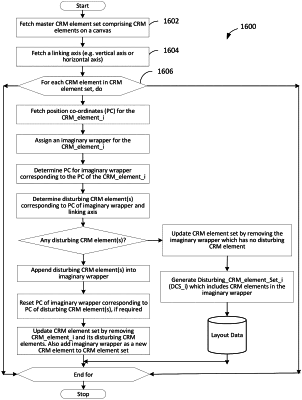| CPC G06F 9/451 (2018.02) [G06F 40/106 (2020.01)] | 14 Claims |

|
1. A method comprising:
locking a first customer relationship management (CRM) element with a unidirectional expansion vector and a second CRM element in a layout that is a disturbing CRM element of the first CRM element of a dynamic CRM page layout, wherein the unidirectional expansion vector includes a static direction and a variable magnitude and the first CRM element includes a graphical display component, a fixed position coordinate at a first boundary of the graphical display component, and a dynamic position coordinate at a second boundary of the graphical display component opposite the first boundary in the static direction of the unidirectional expansion vector;
obtaining first layout data of the first CRM element and second layout data of the second CRM element while instantiating the first CRM element, wherein instantiating the first CRM element includes identifying CRM data for display within the first CRM element and wherein the variable magnitude of the unidirectional expansion vector is determined by how much size is required to display the CRM data in the graphical display component of the first CRM element;
extending the second boundary of the graphical display component of the first CRM element by the variable magnitude of the unidirectional expansion vector in the static direction associated with the unidirectional expansion vector, wherein a dynamic position coordinate value is adjusted in the static direction as dictated by the magnitude of the unidirectional expansion vector;
positioning the second CRM element beyond the second boundary of the graphical display component of the first CRM element in the static direction on the dynamic CRM page;
fetching a component set comprising the first CRM element and the second CRM element;
fetching a linking axis that represents the unidirectional expansion vector with which the first and second CRM elements are locked by a layout building engine;
for each CRM element in the component set, fetching position coordinates (PC) for the component, assigning an imaginary wrapper for the component, determining PC for the imaginary wrapper corresponding to the PC of the component, and determining a set of disturbing components corresponding to the PC for the imaginary wrapper and linking axis, wherein the imaginary wrapper represents a set including at least one CRM element from the component set;
comprising, for each CRM element in the component set with no disturbing components:
updating the component set by removing the imaginary wrapper that has no disturbing component;
generating a disturbing component set (DCS) that includes components in the imaginary wrapper;
adding the DCS to the first layout data of the first CRM element and the second layout data of the second CRM element, wherein the first layout data of the first CRM element and the second layout data of the second CRM element are stored in a layout datastore;
resetting the linking axis to a horizontal axis;
adding each DCS instance to the component set;
determining additional DCS for components in the component set corresponding to the reset linking axis;
adding the additional DCS to the layout datastore.
|